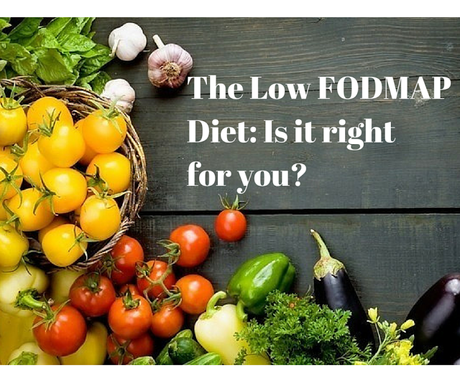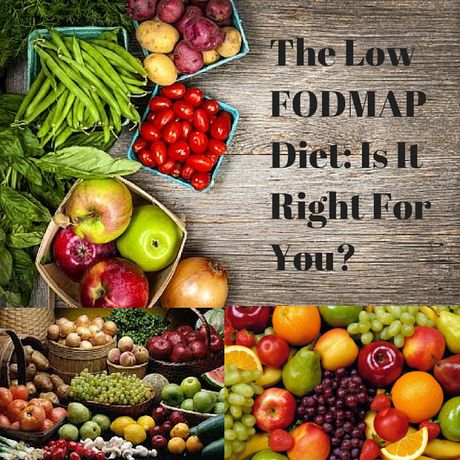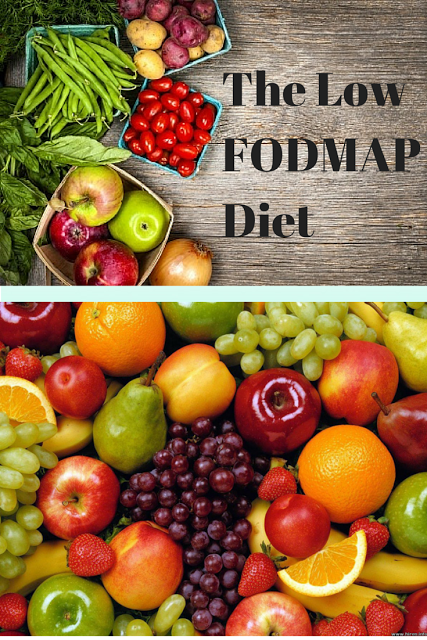 Hi everyone! I hope you are having a good day.
Hi everyone! I hope you are having a good day.If you are a follower of the blog you may remember that a few weeks ago I joined the 2 Strong Guys for a podcast, and one of the topics we discussed was FODMAPS and the low FODMAP diet. So I decided it was time I put together a post dedicated to this topic since the scientific evidence supporting a low FODMAP diet is slowly starting to increase.
So first of all, what are FODMAPS? FODMAPS is an acronym that stands for Fermentable, Oligosaccharides, Dissacharides, Monosaccharides And Polyols. Yes it's a mouthful. Let's break each of these down to examine each one individually.
Fermentable: These carbohydrates are sugars that are broken down and digested by bacteria in the intestines, producing gas and other by-products.
Oligosaccharides: These are short chains of carbohydrates that are linked together. There are two types: fructans (a chain of fructose molecules) and galacto-oligosaccharides (a chain of galactose molecules). Fructans are found in foods like wheat, rye, onions and garlic. Galacto-oligosaccharides are found in legumes and it is known that humans have a hard time breaking these molecules down in the small intestine.
Dissacharides: Disaccharides are two carbohydrate molecules linked together, and lactose, the sugar found in milk and dairy products, is a type of disaccharide composed of glucose and galactose.
Monosaccharides: These are single carbohydrate molecules, and fructose, the sugar found in many fruits and some vegetables, is a monosaccharide. Fructose does not require any digestion before it is absorbed. When foods containing equal amounts of fructose and glucose are eaten, glucose helps fructose get absorbed. However, when fructose is present in a greater proportion than glucose, fructose absorption depends upon the activity of sugar transporters located in the intestinal wall. The ability to absorb excess fructose varies from person to person and in people with fructose malabsorption, the capacity of sugar transporters is limited and excess fructose travels to the colon where fermentation occurs.
AND
Polyols: Polyols, or sugar alcohols, are a type of carbohydrate that humans can only partially digest and absorb in the small intestine. Examples include sorbitol, mannitol, xylitol, maltitol and isomalt.
These sweeteners have a much slower absorption rate than traditional sugar, and only a small amount of what is eaten is actually absorbed.
Okay so now we know what FODMAPS stands for, but what is the big deal?
Well, FODMAPS have been linked scientifically to irritable bowel syndrome (IBS), unexplained abdominal pain (Goebel-Stengel et al., Melchior et al.) and intestinal symptoms in patients with inflammatory bowel disease (Crohn's and Ulcerative Colitis) (reference and reference). And a low FODMAP diet has been found in multiple studies (reference) to help relieve the symptoms of IBS, functional abdominal pain and symptoms in Crohn's or Colitis patients. And since IBS is the most common digestive disorder worldwide, affecting anywhere from 5-20% of the population (reference), which currently does not have a known cure, any dietary strategy to help patients with this condition is a big deal.
And why does this diet work do you ask?Well, on reaching the small intestine and large intestine, FODMAPs increase the osmotic pressure in the bowel (this is a fancy term meaning they draw water toward them) and provide a substance for bacterial fermentation which ultimately leads to gas production, abdominal distension and abdominal pain or discomfort. So by eliminating these problematic foods these symptoms are reduced and the abnormalities that have developed in the intestinal cells can be restored.
Yep that's right, the most common digestive disorder in North America has scientific evidence linking foods as a culprit. And treating patients with IBS, functional abdominal pain and inflammatory bowel disease with a low FODMAP diet helps improve or eliminate symptoms (Magge et al., Halmos et al., de Roest et al). I love it when science supports what so many patients intuitively know!There is also very recent evidence showing that a low FODMAP diet can alter the type of bacteria in the gut (reference) which we know can have a huge impact on not only bowel symptoms, but many other chronic diseases as well. Remember that a healthy gut equals a healthy body. And more and more systemic and chronic diseases are being linked to abnormalities in the gut flora. Diseases from thyroid problems, rheumatoid arthritis, inflammatory bowel disease, allergies, multiple sclerosis, lupus, autism, obesity, diabetes etc... the list goes on and on! So if you haven't had success with the paleo diet alone, you might consider trying a low FODMAP diet to help restore your gut flora and achieve greater healing.
So now that you know what FODMAPS are, here is a list of foods that should be avoided while on a low FODMAP diet:
High FODMAP Foods (Unsafe to Eat)
• Fructose:Honey, Agave, Apples, Mangos, Pears, Watermelon, Blackberries, Nectarines, White peaches, Apricots, Plums, Peaches, Pruines, Mango, Persimmons, Canned fruits, Orange juice, High Fructose Corn Syrup (which we aren’t eating on a whole foods diet anyways – right?)• Fructans:Artichokes, Asparagus, Sugarsnap peas, Cabbage, Cauliflower, Pumpkin, Mushrooms, Green peppers, Garlic, Leeks, Onions (brown, white, Spanish, Onion powder), Spring Onions (the white part), Shallots, Wheat, Rye, and Barley (although as usual I recommend avoiding all grains)• Lactose: Dairy products
• Galacto-Oligosaccharides (GOS): Legume beans (eg. baked beans, kidney beans, bortolotti beans), Lentils and Chickpeas
• Polyols:Apples, Apricots, Avocados, Cherries, Nectarines, Pears, Plums, Prunes, Mushrooms, sorbitol, mannitol, xylitol, maltitol, and isomalt
Yes I realize there are a lot of foods listed there. So what can you still eat? A lot!
Here is a list of suggested foods to continue eating:
Low FODMAP foods (Safe To Eat)
Vegetables and Legumes- Alfalfa
- Bean sprouts
- Bok choy
- Broccoli – avoid large servings
- Brussel sprouts
- Butternut squash
- Carrots
- Corn / sweet corn- if tolerable and only in small amounts – 1/2 cob
- Courgette
- Chilli – if tolerable
- Chives
- Cucumber
- Eggplant / aubergine
- Fennel
- Green beans
- Ginger
- Kale
- Leek leaves
- Lettuce
- Okra
- Olives
- Parsnip
- Parsley
- Bell peppers, except green
- Potatoes
- Scallions / spring onions (green part)
- Spinach, baby
- Squash
- Sweet potato – 1/2 cup
- Tomato – avoid cherry tomatos
- Turnip
- Zucchini
Fruit
- Bananas
- Blueberries
- Boysenberry
- Canteloupe
- Cranberry
- Clementine
- Dragonfruit
- Grapes
- Honeydew and Galia melons
- Kiwifruit
- Lemon including lemon juice
- Lime
- Mandarin
- Orange
- Passion fruit
- Paw paw
- Papaya
- Pineapple
- Raspberry
- Rhubarb
- Strawberry
Meats and Eggs
- All unprocessed meats are allowed (chicken, lamb, pork, turkey, bison, duck etc.)
- Eggs
Fish and Seafood
- Canned tuna or salmon
- Fresh fish
- Seafood (e.g. Crab, Lobster, Shrimp, Mussels, Oysters)
Sweets
- Maple syrup
- Coconut sugar
- Coconut butter, coconut flakes, shredded coconut - **NOTE: coconut is a gray area food in the low FODMAP diet, some experts say it's tolerated, and others don't so you will have to see for yourself
It is generally recommended that you eliminate the high FODMAP foods for 6-8 weeks. If your symptoms improve you know you don't tolerate FODMAPS. However, you may not need to eliminate all the FODMAP foods forever. Some people tolerate certain subgroups of the FODMAPS better than others. Once the 6-8 weeks are up I recommend adding one food back in at a time for a period of 3-5 days and watching for symptoms. Start with a small amount and gradually increase over that 3-5 day period. If your symptoms come back, you know you can't have that particular food, or only in small amounts. This is a great time to use a food journal and chart what you are eating. And remember, symptoms may not appear the same day that you eat the food, you need to monitor for symptoms for a few days after re-introcuding each food item. This is why the food journal is so crucial to the food re-introduction process. It will also allow you to keep track and remember how you felt a few days or months down the road when you are staring at a particular FODMAP and wondering whether to eat it or not!
I hope this was helpful! Please let me know if you try this diet and how it goes for you! As you know I always love hearing from you. And if you have any questions please let me know.
And as always I would love it if you visited my social media pages: Instagram,Facebook, Pinterest and Twitter.
And here are a few resources to help you with recipes and more specific advice on how to implement the low FODMAP diet:
The Low FODMAP 28 Day Plan
The Quiet Gut
The Complete Low FODMAP Diet
The Everything Guide to the Low FODMAP Diet
Monash University Low FODMAP Diet Guide
And please sign up for my newsletter to stay in the loop on new posts, special offers and giveaways!

